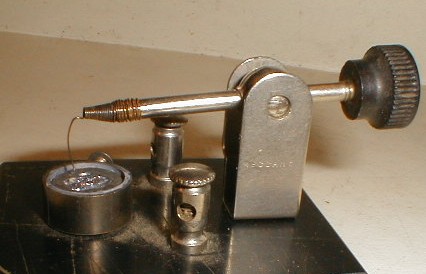
Crystal detector
A crystal detector is an obsolete electronic component used in some early 20th century radio receivers that consists of a piece of crystalline mineral which rectifies the alternating current radio signal.[1] It was employed as a detector (demodulator) to extract the audio modulation signal from the modulated carrier, to produce the sound in the earphones.[2] It was the first type of semiconductor diode,[3] and one of the first semiconductor electronic devices.[4] The most common type was the so-called cat's whisker detector, which consisted of a piece of crystalline mineral, usually galena (lead sulfide), with a fine wire touching its surface.[1][4][5]
This article is about historical crystal detectors. For modern crystal detectors, see Diode § Radio demodulation.
The "asymmetric conduction" of electric current across electrical contacts between a crystal and a metal was discovered in 1874 by Karl Ferdinand Braun.[6] Crystals were first used as radio wave detectors in 1894 by Jagadish Chandra Bose in his microwave experiments.[7][8] Bose first patented a crystal detector in 1901.[9] The crystal detector was developed into a practical radio component mainly by G. W. Pickard,[4][10][11] who discovered crystal rectification in 1902 and found hundreds of crystalline substances that could be used in forming rectifying junctions.[2][12] The physical principles by which they worked were not understood at the time they were used,[13] but subsequent research into these primitive point contact semiconductor junctions in the 1930s and 1940s led to the development of modern semiconductor electronics.[1][4][14][15]
The unamplified radio receivers that used crystal detectors are called crystal radios.[16] The crystal radio was the first type of radio receiver that was used by the general public,[14] and became the most widely used type of radio until the 1920s.[17] It became obsolete with the development of vacuum tube receivers around 1920,[1][14] but continued to be used until World War II and remains a common educational project today thanks to its simple design.
